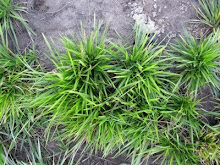A recent paper in PNAS by Erika Edwards (one of our GrassPortal partners) and Stephen Smith provides some novel insights into the environments in which grasses evolved and why certain groups of species are associated with warm or cool regions of the earth. Contemporary tropical and sub-tropical grasslands are dominated by C4 grasses (grasses with “turbo-charged” photosynthesis. See our recent blog post) and temperate grasslands tend to be dominated by C3 grasses. This has led to the long-standing belief that C4 photosynthesis is better adapted to warmer environments.
By reconstructing the evolutionary relationships among grass species, Erika and Stephen have been able to show that our view on this problem may be skewed. The origin of grasses seems to have been in the shade of tropical forests, and evolution has subsequently taken very different turns in two of the major grass lineages. In the first, the evolution of C4 photosynthesis seems to have been associated with a shift to drier, and more open savannas and grasslands in the tropics - so the C4 pathway may be an adaptation to bright tropical sunlight and drier soils. In the second lineage, grasses have evolved cold tolerance, allowing them to radiate out from the tropics and into the cool temperate regions. Here, it is the ability to survive cold conditions, rather than the C3 photosynthetic pathway, that allows these species to grow in temperate climates.
This new work forces us to look at the distribution of grass species in a new way, and clearly highlights the importance of using evolutionary relationships to understand geographical patterns. GrassPortal will make this kind of work significantly easier to carry out in future, providing direct links between phylogenetic (evolutionary relationships) and biogeographic (species distributions) data.
Wednesday, 12 May 2010
Subscribe to:
Post Comments (Atom)


No comments:
Post a Comment